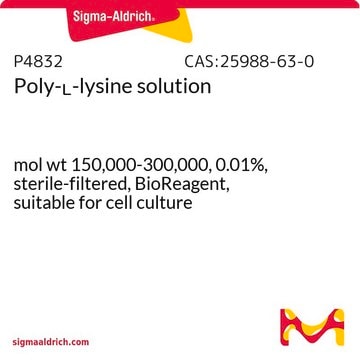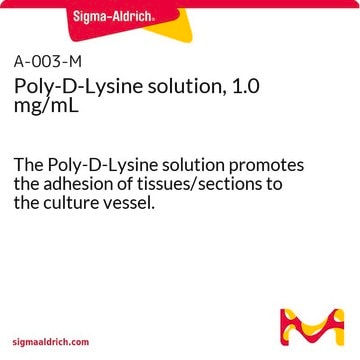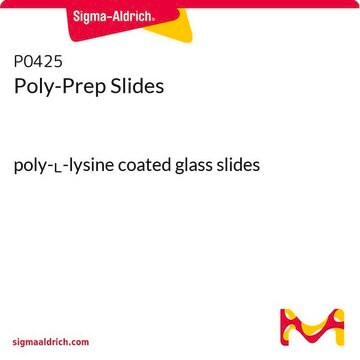Yes, the product P4707 is suitable for coating glassware for cell culture. The difference between Poly L and Poly D lysine lies in their stereoisomeric properties. Poly-L-Lysine is a charge enhancer and can be used for coating many surfaces, including tissue culture plasticware and glassware. However, certain cells can digest poly-L-lysine, in which case the poly-D-lysine, such as P7405, should be used. This product can also be used to coat tissue culture plasticware and glassware.
Kluczowe dokumenty
P4707
Poly-ʟ-Lysine Hydrobromide
synthetic, liquid, 0.01%, suitable for cell culture
Synonim(y):
PLL Solution
Wybierz wielkość
1110,00 zł
Wybierz wielkość
About This Item
1110,00 zł
Polecane produkty
Nazwa produktu
Poly-L-lysine solution, 0.01%, sterile-filtered, BioReagent, suitable for cell culture
sterylność
sterile-filtered
Poziom jakości
linia produktu
BioReagent
Formularz
liquid
masa cząsteczkowa
70—150 kDa
opakowanie
pkg of 50 mL
stężenie
0.01%
metody
cell culture | mammalian: suitable
pokrycie powierzchni
4 μg/cm2
zanieczyszczenia
endotoxin, tested
rozpuszczalność
water: soluble
Warunki transportu
ambient
temp. przechowywania
2-8°C
ciąg SMILES
N([C@@H](CCCCN)C(=O)N[C@@H](CCCCN)C(=O)O)C(=O)[C@@H](N)CCCCN
InChI
1S/C18H38N6O4/c19-10-4-1-7-13(22)16(25)23-14(8-2-5-11-20)17(26)24-15(18(27)28)9-3-6-12-21/h13-15H,1-12,19-22H2,(H,23,25)(H,24,26)(H,27,28)/t13-,14-,15-/m0/s1
Klucz InChI
WBSCNDJQPKSPII-KKUMJFAQSA-N
Szukasz podobnych produktów? Odwiedź Przewodnik dotyczący porównywania produktów
Opis ogólny
Zastosowanie
- Poly-L-lysine coated glass coverslips have been used for mounting samples for scanning electron microscopy.[1]
- Poly-L-lysine coated wells were used for trapping of PC-12 cells on electrodes.[2]
- Poly-L-lysine-coated borosilicate glass slides were used for the seeding of viral vector-transduced cells.[3]
Działania biochem./fizjol.
Komponenty
Uwaga dotycząca przygotowania
produkt podobny
produkt powiązany
Kod klasy składowania
12 - Non Combustible Liquids
Klasa zagrożenia wodnego (WGK)
WGK 2
Temperatura zapłonu (°F)
Not applicable
Temperatura zapłonu (°C)
Not applicable
Wybierz jedną z najnowszych wersji:
Masz już ten produkt?
Dokumenty związane z niedawno zakupionymi produktami zostały zamieszczone w Bibliotece dokumentów.
Klienci oglądali również te produkty
Produkty
Poly-Lysine enhances cell binding with positively-charged surface ions, optimizing electrostatic interaction on culture surfaces for increased cell attachment.
Poli-lizyna zwiększa wiązanie komórek z dodatnio naładowanymi jonami powierzchniowymi, optymalizując interakcje elektrostatyczne na powierzchniach hodowli w celu zwiększenia przyczepności komórek.
3D cell culture overview. Learn about 2D vs 3D cell culture, advantages of 3D cell culture, and techniques available to develop 3D cell models
Przegląd hodowli komórek 3D. Dowiedz się więcej o hodowli komórek 2D i 3D, zaletach hodowli komórek 3D i technikach dostępnych do tworzenia modeli komórek 3D
Protokoły
Adhere cells to solid substrates using poly-lysine, which enhances electrostatic interaction between negatively charged ions of the cell membrane and the culture surface.
Przyleganie komórek do stałych podłoży za pomocą poli-lizyny, która wzmacnia elektrostatyczne oddziaływanie między ujemnie naładowanymi jonami błony komórkowej a powierzchnią hodowli.
-
Is the product P4707 suitable for coating glassware for cell culture? Also, what is the difference between Poly L and Poly D lysine?
1 answer-
Helpful?
-
-
When coating coverslips with item P4707, is it necessary to wash the reagent off after 5 minutes, or is there a different recommended procedure?
1 answer-
The product is provided as a 0.01% sterile filtered solution in water. When coating slides with this solution, it is recommended to incubate for 5 minutes and allow the slides to dry at room temperature.
Helpful?
-
-
How many times can it be reused?
1 answer-
The number of times that this product may be re-applied has not been determined. This would be dependent on several factors, such as surface area, material type, surface pretreatment, and incubation period. Please see the link below to review the product datasheet for additional information:
https://www.sigmaaldrich.com/deepweb/assets/sigmaaldrich/product/documents/244/731/p4707pis.pdfHelpful?
-
-
What is the molecular weight of product P4707?
1 answer-
Poly-L-lysine solution is 70-150 kDa molecular weight.
Helpful?
-
-
How can I sterilize slides coated with Product P4707, Poly-L-Lysine solution?
1 answer-
Poly-L-Lysine coated slides can be exposed to UV light overnight for sterilization.
Helpful?
-
-
What is the protocol for using Product P4707, Poly-L-Lysine solution, to coat tissue culture plasticware?
1 answer-
A solution of 0.1 mg/mL is prepared; 0.5 mL of that solution is aseptically transferred to a non-tissue culture treated 25 square cm flask. The flask is gently rocked to evenly coat the surface. After five minutes, the excess solution is removed and the surface is thoroughly rinsed with sterile water and allowed to dry for several hours.
Helpful?
-
-
Should I use Poly-L-Lysine or Poly-D-Lysine?
1 answer-
Certain cells secrete proteases, which can digest poly-L-lysine. For those cell types, poly-D-lysine should be used.
Helpful?
-
-
What is the protocol for using Product P4707, Poly-L-Lysine solution, to coat slides?
1 answer-
For coating slides with poly-L-lysine, in general, it is recommended to use a 0.01% (w/v) solution. After a 5 minute incubation, the excess solution is removed and the slides are dried at room temperature or in an oven at gentle heat.
Helpful?
-
-
What is the Department of Transportation shipping information for this product?
1 answer-
Transportation information can be found in Section 14 of the product's (M)SDS.To access the shipping information for this material, use the link on the product detail page for the product.
Helpful?
-
-
What is the concentration of Product P4707, Poly-L-Lysine solution?
1 answer-
This product is supplied as a 0.01% w/v solution.
Helpful?
-
Active Filters
Nasz zespół naukowców ma doświadczenie we wszystkich obszarach badań, w tym w naukach przyrodniczych, materiałoznawstwie, syntezie chemicznej, chromatografii, analityce i wielu innych dziedzinach.
Skontaktuj się z zespołem ds. pomocy technicznej







